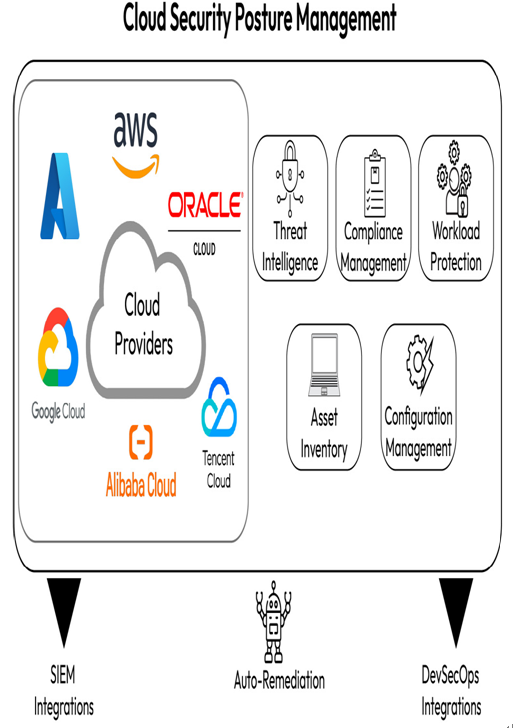CSPM is a type of security tool or solution that helps organizations assess, monitor, and manage the security posture of their cloud environments. The term CSPM was coined by the Gartner research firm in its 2019 innovation paper (https://www.gartner.com/reviews/market/cloud-security-posture-management-tools) and is defined as follows:
“Cloud security posture management tools help in the identification and remediation of risks across cloud infrastructures, including Infrastructure as a Service (IaaS), Software as a Service (SaaS), and Platform as a Service (PaaS). These tools continuously assess the security posture across multi-cloud environments by maintaining a current inventory of the cloud assets for proactive analysis and risk assessment to detect any misconfigurations. Once these misconfigurations are identified, security controls are developed and implemented. CSPM solutions also integrate with DevOps tools, streamlining the incident response process and ensuring continuous compliance with regulatory requirements and security frameworks by providing visibility of the cloud environment’s security posture.“
Gartner also notes that CSPM solutions can be integrated with a variety of other security tools and solutions, such as Cloud Access Security Brokers (CASBs), DevOps tools, Security Information and Event Management (SIEM), and Data Loss Prevention (DLP) to provide a comprehensive view of the security posture of cloud environments. Most CSPM tools come with inherent features of vulnerability management; however, they can also integrate with existing vulnerability management solutions to ensure that vulnerabilities are identified and addressed in the cloud environment. CSPM solutions can provide visibility into the cloud environment and identify vulnerabilities that could be exploited by attackers.
Gartner also highlights in that research paper that “nearly all successful attacks on cloud services are the result of the customer side of misconfiguration, mismanagement, and mistakes.”
Gartner refers to CSPM as a new market sector for vendors. Here are some features that a CSPM should have as per Gartner’s recommendations:
- Asset discovery: CSPM solutions should be able to identify all assets in the cloud environment, including virtual machines, containers, storage, and network resources. This helps organizations to ensure that their cloud environment is secure and compliant with relevant regulations and standards.
- Configuration management: CSPM solutions should be able to identify misconfigurations in the cloud environment and provide guidance on how to remediate them. This includes ensuring that cloud resources are configured in line with best practices for security and compliance.
- Vulnerability management: CSPM solutions should be able to detect vulnerabilities in the cloud environment and provide guidance on how to address them. This includes prioritizing vulnerabilities based on the severity of the risk they pose and providing recommendations for remediation.
- Compliance monitoring: CSPM solutions should be able to monitor compliance with relevant regulations and standards, including HIPAA, PCI DSS, and GDPR. This includes providing reports and alerts on compliance status and identifying areas where improvements can be made.
- Threat detection and response: CSPM solutions should be able to detect potential security incidents in the cloud environment and provide guidance on how to respond to them. This includes identifying Indicators Of Compromise (IoCs) and providing recommendations for incident response.
- Cloud governance: CSPM solutions should provide organizations with the ability to manage cloud governance policies and automate compliance workflows. This includes providing templates for cloud governance policies and automating compliance assessments and remediation.
- Integration with other security solutions: CSPM solutions should integrate with other security solutions, such as SIEM, DLP, and IAM solutions, to provide a comprehensive approach to cloud security. This includes sharing threat intelligence and security information across different security solutions to improve overall security posture.

Figure 2.1 – Cloud Security Posture Management
CSPM tools empower organizations by identifying and remediating the risk through security assessments and automated compliance monitoring for Infrastructure as a Service (IaaS), Platform as a Service (PaaS), and Software as a Service (SaaS) across the Azure public cloud, AWS, Google Cloud, and hybrid clouds. CSPM tools are also growing over time in terms of their features and capabilities. Initially, CSPM tools helped in visualizing the IaaS and PaaS asset inventory; however, their most recent version is richer and more robust, with auto-remediation capabilities that reduce overhead.
In short, CSPM is a crucial tool for organizations that are leveraging cloud services, as it helps to ensure that their cloud environment is secure and compliant with industry standards and best practices. Now that you have an understanding of CSPM, let us understand the importance of CSPM tools.
